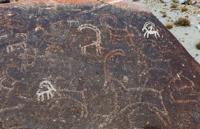You are here
Rock Art Sites in Uzbekistan.

Rock Art Tours in Uzbekistan.
“It was up this causeway that the Tajik ancestors, the Sogdians, had fled from Arab invaders in the eighth century. For more than fifteen hundred years they had lived along the Zerafshan in a loose-linked galaxy of oasis princedoms. Rut Turkic and Arab incursions at last confined ed them to the great cities, where their Tajik descendants survive, or drove them deep into the mountains, and the valley which we followed still seemed to echo their desperate migration”
The Lost Heart of Asia, Colin Thubron.
Archeology and Petroglyphs Uzbekistan.
Petroglyphs and rock paintings are common in Uzbekistan, in semi-desert, foothill and mountainous terrain. Large areas in the eastern and central part of the republic are occupied with the mountain massifs of the Alai, Western Tien-Shan, Hissar, Zaravshan and Nurata ranges.
Even the Kyzyl Kum, commonly perceived as an endless desert, abounds with mountains and gorges. Carved and painted images or entire panels can be found over smooth surfaces suitable for drawing on limestone, shale, granite, and sandstone rocks. Images occur under overhangs and in shelters.
No cave drawings have yet been discovered. Uzbekistan rock art is as numerous and diverse as any in other Central Asian countries. Peoples and tribes who used to inhabit the country in antiquity left behind these rich “picture galleries” in the open air.
At present, more than 150 rock art sites, from the Mesolithic to the Late Middle Ages, have been discovered in its mountainous and foothill areas. Petroglyphs are mainly concentrated in the central (Nurata and Zarafshan ranges), north-eastern (Western Tien-Shan, Turkestan and Alai ranges, Fergana Valley), north-western (Central Kyzyl Kum, Mountains of Bukantau, Tamdytau, Sultan Uvays, Kuldzhuktau) and southern (Kugitang Range) parts of Uzbekistan.
The central and northeastern regions of the republic have the greatest concentration of sites with numerous images from different periods. The rock art sites of the Northwestern Tien Shan and Fergana that nowadays belong to neighboring republics - Kazakhstan, Kyrgyzstan and Tajikistan - are inseparable from the sites of the same historical, cultural and geographical context.
Petroglyphs are numerically dominant, although sites with paintings are found in almost all areas. The best known paintings are in the Zaraut-Kamar Grotto (Kugitangtau Range), Siypantash ledge rocks (southern slope of the Zarafshan Range), Aksaklatasay and Sangizhumasay (Nurata Range); paintings in Zaraut-Kamar, Siypantash and Aksaklatasay probably date to the Late Stone Age (Mesolithic? Neolithic), making them some of the oldest rock art sites in Central Asia.
In a small petroglyph site in Khojakent (Chatkal Range) images possibly date to the Eneolithic (Chalcolithic) (IV-III millennia B.C.). The most important and well-researched petroglyph sites include Sarmishsay, Yangiaryksay, Varzik, Khojakent, Karakiyasay, Sayhansay, Tusinsay, Burgansay, Aksakalatasay, Bukantau and many others.
Three sites on the Tentative List of UNESCO World Heritage Sites of Uzbekistan - Sarmishsay, Zaraut-Kamar and Siypantash- are potential World Cultural Heritage sites. P.I. Demezon, who visited the interior of Kyzyl Kum as part of the Russian army in 1834 (Oskin 1985: 4) and discovered rock art in Uzbekistan in the Bukantau mountains, can be considered the first discoverer of rock art in Central Asia.
However, the scientific research of Uzbekistan petroglyphs actually only began in the XXth century and continues to this day.
Authority:
Muhiddin Khujanazarov.
Photos by
Alexander Petrov.







